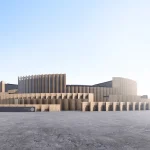Bjarke Ingels Group is restoring a former supermarket into the new Museum for Paper Art in North Jutland, Denmark. The project celebrates Denmark’s rich heritage in paper art, from Le Klint’s folded lampshade designs to H.C. Andersen’s paper cutouts. Founded by calligrapher Bit Vejle in 2018, the museum is the Nordic region’s only institution dedicated to the fine arts on paper.
“Paper art is deeply embedded in our cultural heritage, showcased through Denmark’s paper art tradition with iconic designs such as Le Klint’s folding lamps and H.C. Andersen’s paper clips. Carrying this legacy into the future is something that this museum has at its heart. We are also proud of recycling an existing building.” said Karen Bit Vejle, Artist and Director at the Museum for Paper Art.
The new renovation will add to the existing 900 sqm tenfold, to 2,300 sqm, including new workshops, event spaces, and educational facilities—the sustainable goals in BIG’s design aim for a certification of DGNB Gold or Platinum. The museum showcases a lightweight roof structure with the visual appearance of a folded piece of paper, an interpretation of the integration of old and new.
Origami-like art designs in acoustic panels on the façade lend a dynamic feel to the artistry of this building. The indoor timber surfaces will evoke the craftsmanship of papermaking, while outside spaces will use native flora so that this may serve as a public space for visitors to experience art and nature.
“Paper art is about creating three-dimensional shapes and complex images from a monochromatic, two-dimensional material – a sheet of paper. By treating the roof surface as such – a single sheet of folded paper – existing and new functions are brought together in one unifying gesture. The expressive is accentuated by the clear, complexity arises from simplicity. And an obsolete supermarket finds new life under the floating curved roof.” said Bjarke Ingels, Founder and Creative Director of BIG.
“In collaboration with Bit, we have designed a simple concept that allows a single sheet of paper to drape over the site and the existing building. In this way, the old and new are connected under one roof. In the foyer and assembly space, the old structure is clearly felt within the new one – a unified space inspired by paper and crafted in wood.” stated David Zahle, Partner of BIG.






















Leave a comment